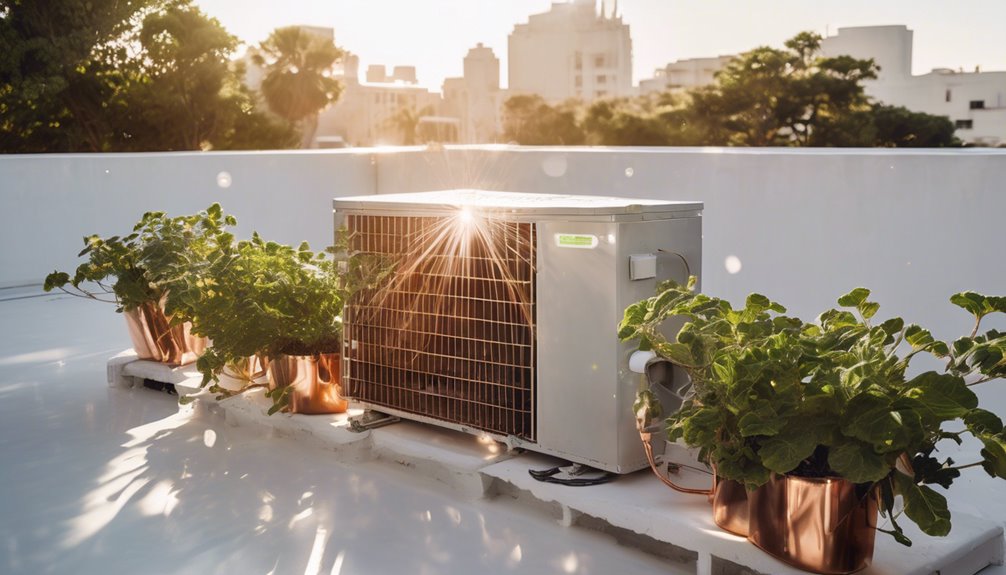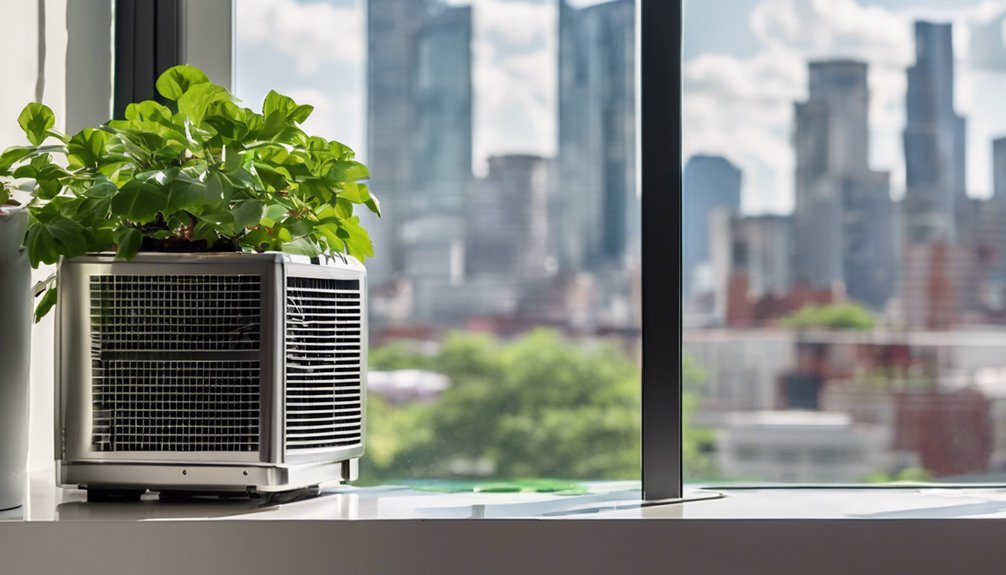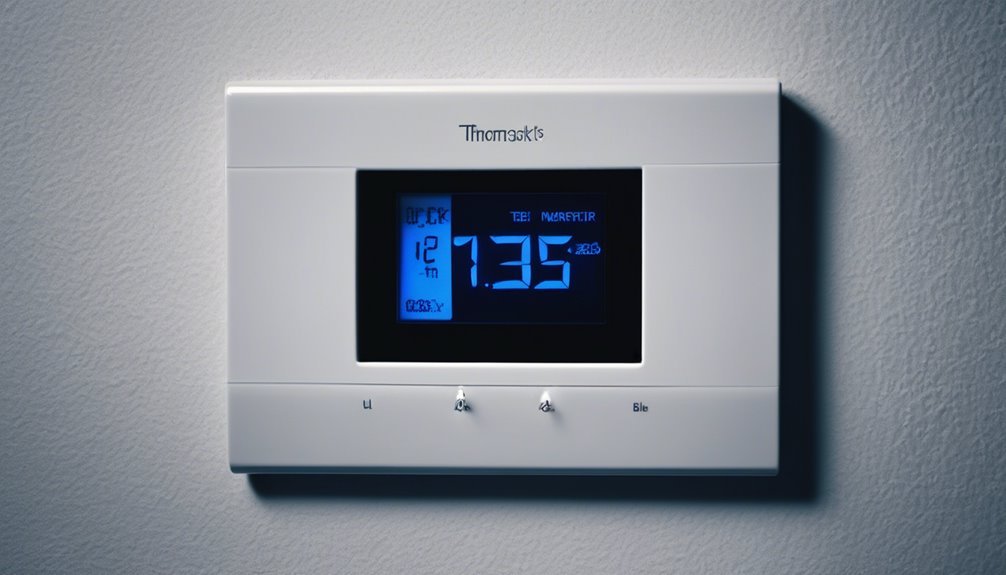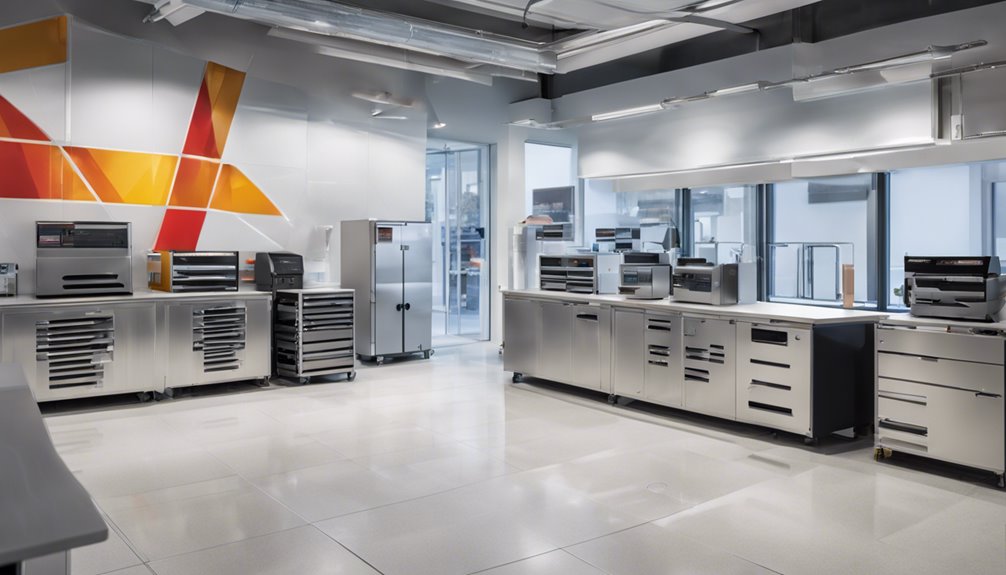To improve your AC's cooling efficiency, start by maintaining your air filters, replacing them every 1-2 months to ensure efficient airflow. Next, identify and repair any hidden refrigerant leaks, and seal gaps in your insulation to reduce heat gain. Adjust your thermostat settings strategically, considering cooling modes and temperature differentials. Ensure your AC unit is properly installed and consider regular maintenance contracts for priority service and discounts. By tackling these essentials, you'll be well on your way to boosting your AC's cooling efficiency – and there's more to explore to get the most out of your system.
Key Takeaways
- Install high-quality air filters with high MERV ratings and replace them every 1-2 months to maintain efficient AC operation.
- Seal refrigerant leaks and gaps in insulation to prevent heat gain and reduce energy consumption.
- Optimize thermostat settings by using cooling mode strategies, managing temperature differentials, and scheduling smart savings.
- Ensure proper AC unit installation, maintenance, and regular checks to prevent breakdowns and maintain efficiency.
- Consider signing up for a maintenance contract with a local HVAC company to receive priority service, discounts, and peace of mind.
Optimizing Air Filter Maintenance
Your air conditioner's air filter plays a crucial role in maintaining its cooling efficiency.
A high-quality filter ensures that your AC unit operates at its best, circulating clean air throughout your home. When choosing a filter, look for one with a high MERV rating, which indicates its ability to capture small particles and contaminants.
Proper filter placement is also essential. Make sure it's installed correctly, with the airflow arrows pointing towards the AC unit.
A dirty or poorly placed filter can reduce your AC's efficiency, leading to increased energy bills and reduced airflow. By selecting a high-quality filter and installing it correctly, you'll be able to breathe easy and enjoy a cooler, more comfortable living space.
Identifying and Repairing Refrigerant Leaks
You'll need to identify hidden refrigerant leaks, which can be a challenge, but it's crucial to optimizing your AC's cooling efficiency.
To do this, you'll need to locate the source of the leak, whether it's a faulty valve, worn seals, or corroded lines.
Detecting Hidden Leaks
Refrigerant leaks can be a major culprit behind inefficient air conditioning, causing your unit to work overtime and driving up energy bills.
To detect these hidden leaks, you'll need to employ effective leak detection methods. One approach is to use pressure testing tools, which can help identify even the smallest leaks. These tools work by pressurizing the system and then monitoring for pressure drops, indicating where the leak is located.
You can also use ultrasonic leak detectors, which pick up the high-frequency sounds emitted by escaping refrigerant. By combining these methods, you'll be well-equipped to sniff out those hard-to-find leaks and get your AC running smoothly again.
Locating Leak Sources
Once you've detected a refrigerant leak, the next step is to pinpoint its source.
You'll need to employ effective leak detection methods to identify the exact location of the leak. Start by inspecting the AC unit's components, such as valves, fittings, and connections, for signs of refrigerant oil or other indicators of a leak.
You can also use pressure testing tools, like halogen leak detectors or ultrasonic leak detectors, to help you narrow down the search. These tools can detect even the smallest leaks, making it easier to locate the source.
Sealing Refrigerant Gaps
Now that you've identified the source of the leak, it's time to seal the gap and restore your AC's cooling efficiency.
Depending on the type of refrigerant your system uses (R-410A, R-22, or others), you may need specialized equipment to repair the leak.
Use leak detection tools like ultrasonic leak detectors or refrigerant sniffers to pinpoint the exact location of the leak.
Once you've located the source, seal the gap using appropriate materials, such as epoxy or sealant tapes.
Make sure to follow the manufacturer's instructions for the repair material and take necessary safety precautions when handling refrigerants.
Enhancing Insulation and Sealing Gaps
Proper insulation and sealing gaps are crucial to maintaining a cool indoor climate while minimizing your air conditioner's energy consumption. You can achieve this by identifying areas in your home where heat can escape or enter, such as windows, doors, and ducts. Consider insulation upgrades, like adding insulation to your attic or walls, to reduce heat gain during summer.
| Solution | Benefits | Cost |
|---|---|---|
| Weatherstripping solutions | Reduces air leaks, lowers energy bills | Low ($10-$50) |
| Insulation upgrades | Reduces heat gain, increases comfort | Medium ($100-$500) |
| Caulking and spray foam | Seals gaps, prevents air leaks | Low ($10-$50) |
Adjusting Thermostat Settings for Efficiency
You can optimize your AC's cooling efficiency by adjusting your thermostat settings strategically.
By implementing the right cooling mode strategies, temperature differential management, and scheduling smart savings, you can reduce energy consumption and lower your bills.
Cooling Mode Strategies
Your thermostat settings play a crucial role in maximizing your air conditioner's cooling efficiency. By adjusting your thermostat settings strategically, you can reduce energy consumption and lower your utility bills. One effective strategy is to use dehumidifying modes during humid days to remove excess moisture from the air, making your AC work more efficiently.
| Mode | Description | Benefits |
|---|---|---|
| Cooling | Reduces temperature | Fast cooling, ideal for hot days |
| Dehumidifying | Removes excess moisture | Reduces humidity, prevents mold growth |
| Auto | Combines cooling and dehumidifying | Optimizes cooling cycles, saves energy |
Temperature Differential Management
The thermostat's temperature differential setting determines how much the AC kicks in when the room temperature rises.
You can adjust this setting to optimize your AC's cooling efficiency. A lower temperature differential means the AC will kick in sooner, but it'll also increase your energy consumption. On the other hand, a higher differential will delay the AC's activation, but it'll reduce your energy bills.
To find the sweet spot, perform a cooling load calculation to determine the ideal temperature differential for your space. Conduct a temperature gradient analysis to identify areas with high heat gain and adjust the differential accordingly.
Scheduling Smart Savings
Optimizing the thermostat's temperature differential setting is just the starting point for maximizing AC cooling efficiency.
To take it to the next level, you need to schedule smart savings by adjusting your thermostat settings according to your daily routine.
Here's how you can do it:
- Time blocking: Divide your day into blocks of time when you're home, away, or sleeping, and adjust the temperature accordingly.
- Energy calendars: Create a calendar to schedule temperature changes based on your daily routine, such as lowering the temperature when you're away or sleeping.
- Smart scheduling: Use a smart thermostat to automate temperature changes, so you don't have to remember to do it manually.
- Override options: Allow for occasional overrides, such as when you're working from home or having guests over, to ensure you're not wasting energy.
Ensuring Proper AC Unit Installation
Proper installation is crucial to getting the most out of your air conditioner.
You need to ensure your unit is placed in a spot that allows for optimal airflow. This means avoiding areas with high obstacles, like furniture or walls, which can block the flow of cooled air.
Optimize airflow by placing your AC in an open area, away from obstacles like furniture and walls that can block cooled air.
When you're installing your AC, you should also perform installation checks to verify that it's working correctly.
Check the refrigerant charge, thermostat calibration, and airflow balance to ensure everything is in order. Additionally, make sure your unit is level and securely fastened to the floor or wall to prevent vibrations and noise.
Scheduling Regular Professional Maintenance
Now that your AC unit is installed correctly, it's time to think about the long-term plan to keep it running efficiently.
Scheduling regular professional maintenance is crucial to ensure your AC continues to cool your home effectively.
Create a maintenance schedule with the following tasks:
- Seasonal checks: Have a technician inspect your AC unit before the peak summer season to identify potential issues.
- Schedule maintenance reminders to ensure you don't forget about these checks.
- Clean or replace your air filters every 1-2 months to improve airflow and efficiency.
- Consider signing up for a maintenance contract with a local HVAC company to get priority service and discounts.
Frequently Asked Questions
Can I Use a Dehumidifier to Improve AC Cooling Efficiency?
You're wondering if a dehumidifier can help in a humid climate. Yes, you can use one to remove excess moisture, making the air feel cooler, and allowing your AC to work more efficiently in dry air.
How Often Should I Clean My AC Condenser Coils?
You should clean your AC condenser coils every 1-3 months, depending on usage and environment. Dirty coils reduce airflow, increase energy bills, and even cause system failure, so regular cleaning is crucial to maintain optimal performance.
Will a Smart Thermostat Really Save Me Money?
You're wondering if a smart thermostat will really save you money. Yes, it can! By tracking your energy usage and optimizing your temperature settings, you'll waste less energy and see lower bills.
Can I Install an AC Unit Myself to Save Money?
You're considering a DIY installation to save money, but don't forget to check if you need local permits before starting the project. While it's possible to install an AC unit yourself, it's crucial to ensure you're complying with regulations to avoid costly fines.
Does Using a Ceiling Fan Really Help AC Cooling?
You're wondering if ceiling fans really make a difference – and yes, they do! Running your fan in a counterclockwise direction during summer creates a cooling breeze, improving air circulation, which can make your space feel up to 4 degrees cooler.
Conclusion
By implementing these simple yet effective tips, you'll be well on your way to improving your AC's cooling efficiency. You've optimized air filter maintenance, identified and repaired refrigerant leaks, enhanced insulation and sealing gaps, adjusted thermostat settings, ensured proper AC unit installation, and scheduled regular professional maintenance. Now, you can relax and enjoy the comfort of your efficiently cooled space, knowing you're saving energy and reducing your utility bills.



